How Clean Or Remove Or Clear Overgrown Vegetable Garden
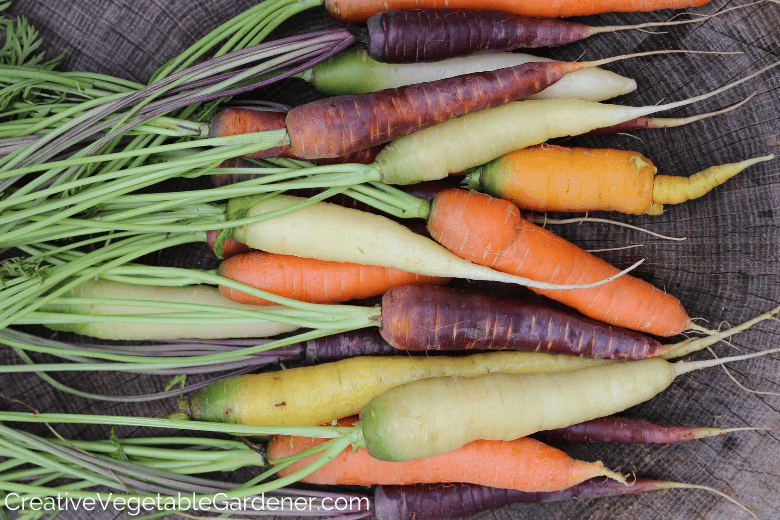
If you've successfully mastered the art of growing carrots you may find yourself with a surplus at some point during the season. That's why it's important to know how to store carrots from the garden so you can enjoy the fruits of your labor for many weeks and months.
Carrots are one of the most fun vegetables to grow! Kids and adults both love to eat them, they're super satisfying to harvest, they can be eaten raw or cooked, and they come in many colors of the rainbow.
And because carrots store quickly and easily for a long time, there really isn't such a thing as too many carrots. At least in our house!
I've harvested carrots from my garden up until December in zone 5, stored them using the method I describe below, and was still using them fresh the next April and May.
That's over 6 months of storage!
If you find yourself with a bumper crop this season, rest assured that you don't have to give all of those beautiful carrots away (unless you want to…), you can follow the steps below for how to store carrots from the garden.
You'll never have to say, "I grew too many carrots." again.
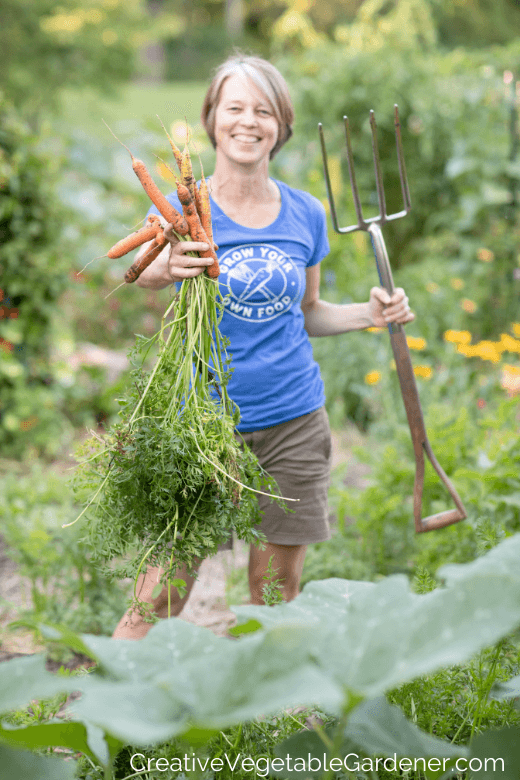
This post contains affiliate links.
How to Plant and Harvest Carrots From the Garden
Spring Planted Carrots
Many gardeners start planting carrots in early spring. Carrots are a frost hardy vegetable that can be planted about four weeks before your average last frost. I plant mine around the first or second week in April in zone 5.
Carrots take anywhere from 60 to 100 days to grow to harvest size, depending on variety, so spring planted carrots are generally harvested during the summer months.

Fall Carrots
You can keep planting carrots until about 10-12 weeks before your average first frost in fall. This is called succession planting and carrots are the perfect candidates for summer planting.
In my garden, my last planting of carrots usually happens mid- to late July. I grow a lot of onions and garlic, so after harvesting them in July I fill some of that space up with carrots.
I love growing fall carrots because they can hang out in the garden for a long time – even into my Wisconsin winter. The cold weather and frosts sweeten them, so they taste delicious.
And they don't grow as quickly in the fall since the days are getting shorter at this time of year, so you can leave them in the garden for a long time and not worry that they'll get overgrown and woody.
In fact, in most years I leave my carrots in the garden beds until right before the ground freezes. They'll turn to mush if you let the ground freeze around them, so make sure you harvest the entire bed before that happens. I'm usually out in my garden in early December digging up the last of the carrots through a light covering of snow.
You can harvest them as you need them for cooking and eating, but feel free to leave the rest in the garden bed.
>>If you're still struggling with your technique read more about how to grow carrots.

How to Harvest Homegrown Carrots
You can harvest a carrot at whatever size you want. If you like really tiny and skinny carrots like you might get at a gourmet restaurant then feel free to dig them up at that size. I prefer mine to be on the larger size, but not so big they start to get woody.
To see if the carrots are ready to harvest, go out to the garden bed and use your finger to dig around where the carrot top meets the soil to see how big the carrot root has grown.
If it looks like it's about time to start harvesting, pull one or two to check out their size. Remember, different varieties take varying lengths of time to grow to mature size.
It's very easy to break carrots when harvesting them. I recommend using a digging fork to gently loosen the soil around the rows until you can gently pull the carrots from the ground.
If you'd like, you can gradually harvest your carrots as you're ready to eat them. They will continue to grow if left in the garden (unless it's mid to late fall in northern areas), so just be careful you don't leave them in there too long or you'll get monster roots!
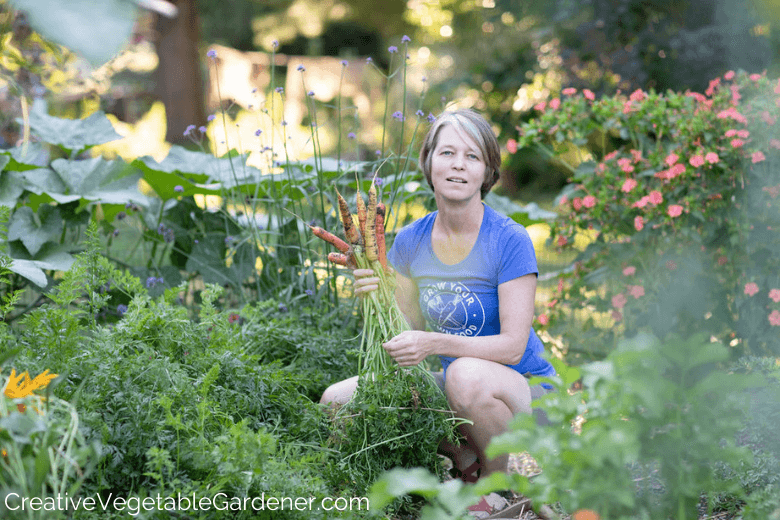
Directions for How to Store Carrots From the Garden
Whether it's summer or fall, when you're ready to harvest them, here's how to store carrots from the garden.
Step 1: Harvest
Harvest all of the carrots that are a mature size. Remember, you can leave smaller carrots in the ground to keep growing unless the ground is about to freeze.
Brush off any excess soil back into the garden bed. I like to harvest mine into a crate for easy transport.
Step 2: Gather Supplies
Grab a pair of garden scissors or pruners and some plastic bags. You can use plastic handled bags, produce bags, or any other plastic bag you have around.
Step 3: Remove Greens
Remove the greens from the carrots by cutting them with the pruners (my fav!) pretty close to the top of the carrot root.
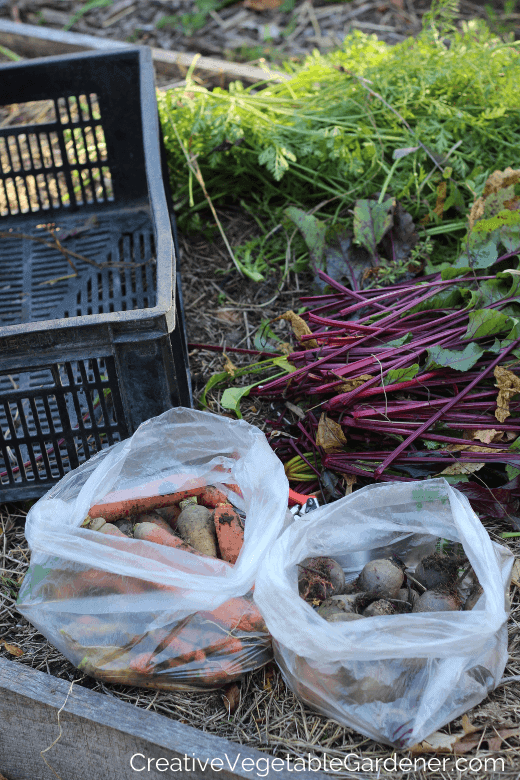
Step 4: Save or Compost Greens
Carrot greens are edible, although I have to admit I usually just compost them. Try Love and Lemons Carrot Greens Chimichurri or Carrot Top Pesto.
Optional Step: Dry Out Carrots
If your carrots are wet and muddy, maybe because it's rained recently, or you have heavy soil, you may want to lay them out to dry before putting them into storage.
Spread newspaper or a tarp in a location out of the elements and freezing weather, a heated garage or your basement. Lay the carrots out in a single layer overnight to dry and then continue with the remaining steps.
Don't leave them out too long or they'll become limp!
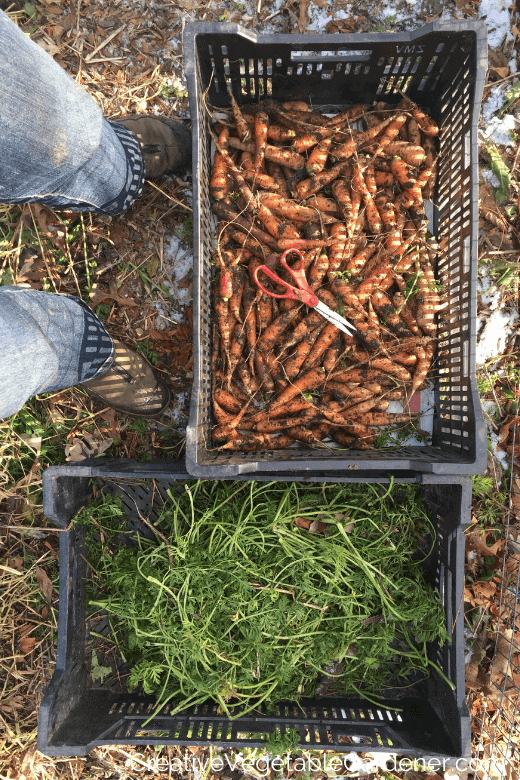
Step 5: Load into Bags
Transfer the carrots into the plastic bags with the soil on. This is an important step! Do not wash your carrots before storage. Many vegetables have a waxy layer that protects them and if you scrub this off by with washing you'll compromise their storage life.
If you're only storing a small amount of carrots for a short period of time you can feel free to wash them clean.
Step 6: Create Air Holes
Poke a few small holes in the bags to let moisture and humidity escape. I've found this keeps the carrots drier in storage so they last longer.
Step 7: Store Carrots
Clear some space in a back corner of your fridge and transfer the bags of carrots there. I usually store my harvest in the back part of the lowest shelf so they're out of the way.
A common question I get when I talk about this in workshops is "Do you have two fridges?". I don't. I have plenty of room in my fridge for vegetables. In fact, that's all we have in there except for a few condiments. If your fridge is full to bursting it might be time to clean it out.
I find that a minimalist fridge helps me avoid food waste and keep on top of what's actually in there so I can use it up. There's also only two of us in our household, so that helps, too.
Step 8: Clean As You Need Them
When you need carrots for a recipe, take a portion from the bag, scrub them off in a bowl of water, and use them. I usually dump the dirty water on our compost pile instead of sending the soil down the drain. Easy peasy!
Step 9: Check the Carrots in Storage
The last critical step in learning how to store carrots from the garden is to remember to check them periodically to make sure none of them are rotting and infecting the rest of the bag. This situation can become pretty gross really quickly. Ever smelled a bag of rotten carrots? Eew.
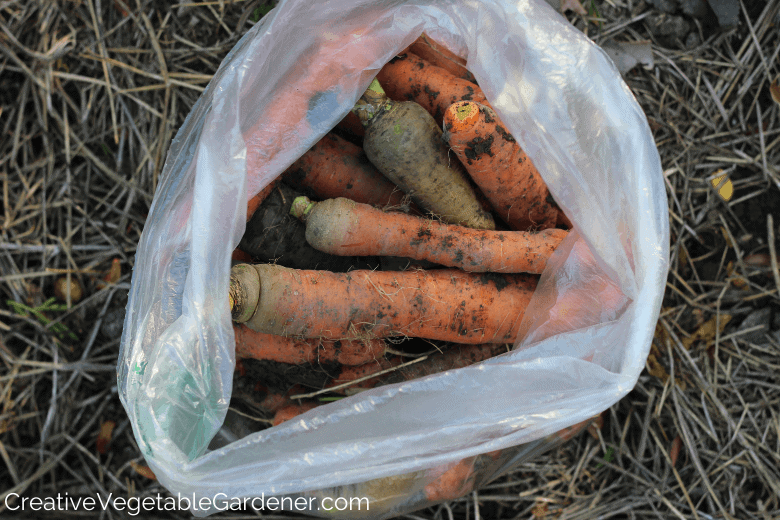
How long do carrots store?
I've had carrots store with this method until the April and May of the following year. In late winter or early spring sometimes the carrots will start to sprout from the tops again. This isn't great because it means the greens will pull energy from the root as they grow. This is a good time to start making a plan to use up the rest of your carrots.
If you're wondering how to store beets you can use a very similar method to this one.
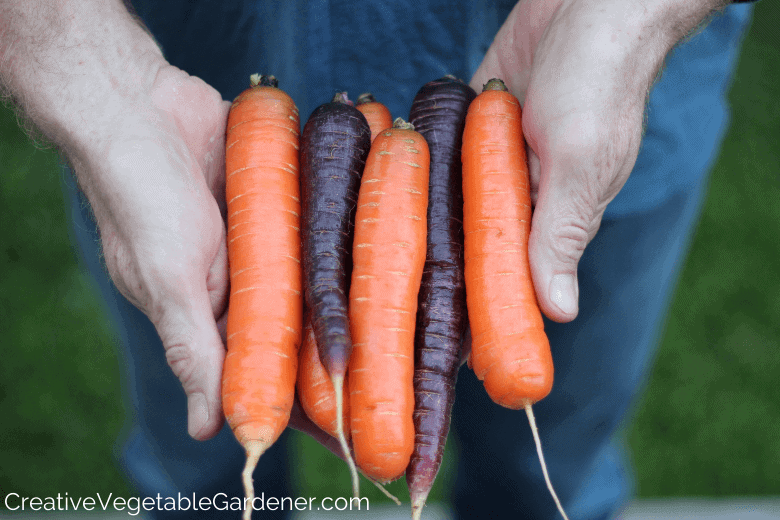
If you like the idea of having your own local, healthy, organic ingredients to cook with throughout the season I highly recommend growing extras of vegetables that store easily (like carrots) and can be used in all kinds of recipes.
Now that you know how to store carrots from the garden you can expand that knowledge and focus on other foods you can easily preserve like storing homegrown onions, drying garlic, putting away potatoes, and keeping beets fresh in your fridge. All winter long you'll save yourself lots of trips to the grocery store and save money in the process.
What's not to love about that?
Additional Resources for Easy Food Preserving & Storage
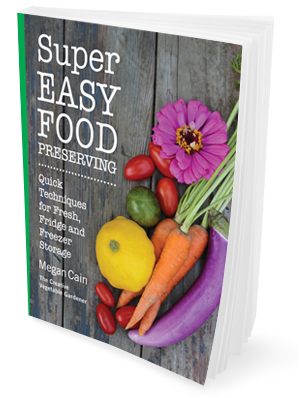
Want more quick and easy ideas for preserving food?
In this book I'll teach you how to use your basement, fridge, and freezer to eat from your garden all 12 months of the year. Check it out here.
.
MASTERCLASS: Fill Your Pantry From Your Garden.
This winter, imagine grabbing all the ingredients you need for a meal right from your pantry, without having to go to the grocery store. With a few simple techniques you can continue to enjoy food grown in your own garden (or purchased from the farmers market) throughout the long, cold months of winter.
This class will teach you how to make every harvest last longer by quickly and easily preserving vegetables at the height of their season. You'll love the feeling of sitting down to a meal and knowing a large part of it came from your garden!
Join the Masterclass now!
SHARE IT ON PINTEREST
How Clean Or Remove Or Clear Overgrown Vegetable Garden
Source: https://www.creativevegetablegardener.com/how-to-store-carrots-from-the-garden/
Posted by: mccabethiss1969.blogspot.com

0 Response to "How Clean Or Remove Or Clear Overgrown Vegetable Garden"
Post a Comment